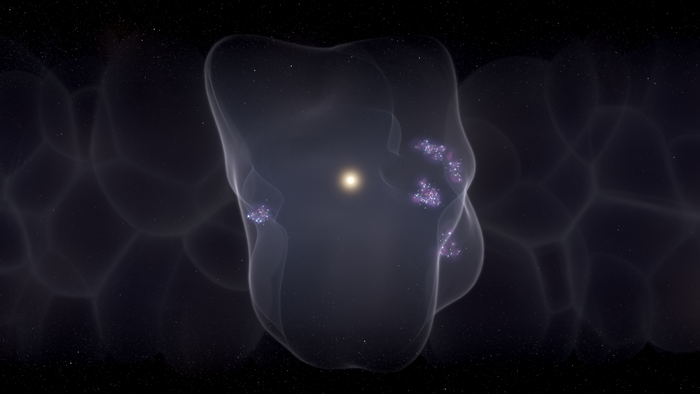Earth is at the center of a 1,000-light-year-wide 'Swiss cheese' bubble carved out by supernovas
By Harry Baker published about 15 hours ago
The cosmic void is surrounded by multiple star-forming regions created by the explosions.

Artist's illustration of the Local Bubble with the sun's location in the center and star formation occurring on
the bubble's surface. (Image credit: Leah Hustak (STScI))
Earth is slap bang in the middle of a 1,000 light-year-wide bubble with a dense surface birthing thousands of baby stars. Researchers have long wondered what created this "superbubble." Now, a new study suggests that at least 15 powerful star explosions inflated this cosmic bubble.
Astronomers in the 1970s first discovered the gigantic void, known as the Local Bubble, after realizing that no stars had formed inside the blob for around 14 million years. The only stars inside the bubble either existed before the bubble emerged or formed outside the void and are now passing through; the sun is one such trespasser. This setup had suggested that several supernovas were responsible for this void. Those stellar explosions, the researchers said, would have blasted the materials needed to make new stars, such as hydrogen gas, to the edge of a huge area in space, leaving behind the Local Bubble that's surrounded by a frenzy of star births.
In the new study, published online Jan. 12 in the journal Nature, researchers accurately mapped the star-forming regions surrounding the Local Bubble and, in doing so, calculated how fast the superbubble is expanding. This allowed the team to work out exactly how many supernovas were needed to carve out the gigantic cosmic void and better understand how star-forming regions are created across the Milky Way.
"By tracing back the positions and motions of nearby young stars over the past millennia, we have reconstructed the history of our galactic neighborhood," lead researcher Catherine Zucker, a NASA Hubble fellow at the Space Telescope Science Institute in Maryland, told Live Science.
More:
https://www.livescience.com/earth-trapped-in-local-bubble
